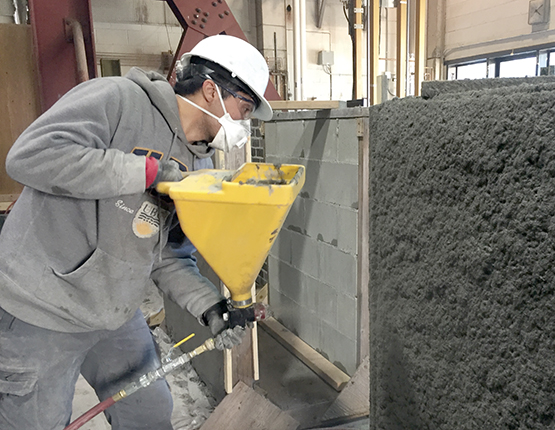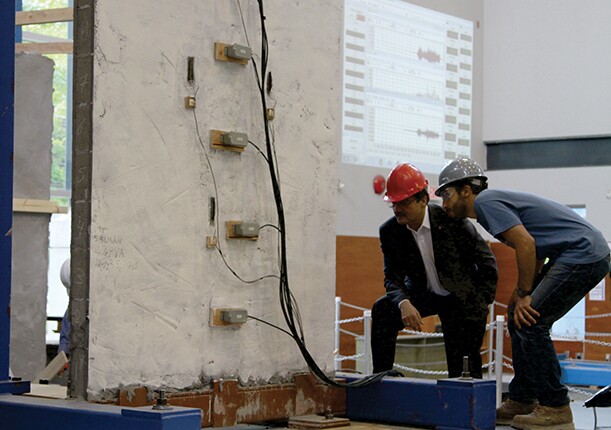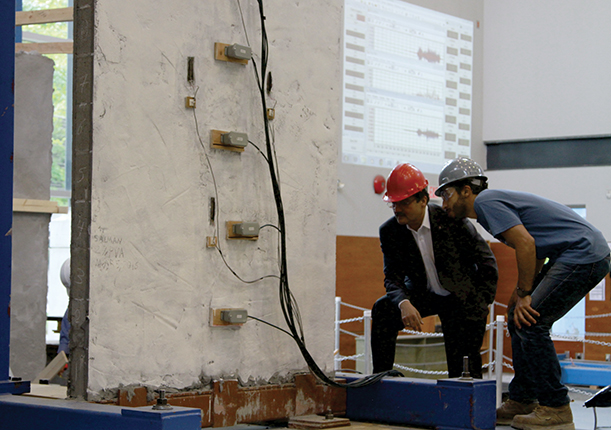A spray-on material can retrofit walls to save lives in earthquakes
DOI: 10.1063/PT.3.3788
Two dozen countries have experienced deadly earthquakes in the past decade. Nemkumar Banthia and his research group at the University of British Columbia, Canada, have spent several years in the lab shaking walls in ways that mimic earthquakes. As a result of that work, they have engineered a coating that they say can keep non-load-bearing masonry walls standing in earthquakes stronger than the 9.0 temblor that rattled northeastern Japan on 11 March 2011. In November they began applying their eco-friendly ductile cementitious composite (EDCC) to seismically strengthen a local Vancouver public school; next in line is a school in Roorkee, Uttarakhand, a highly seismic area of northern India.
A layer of EDCC almost doubles the amount of deformation that a masonry wall can sustain, says Salman Soleimani, who will defend his PhD thesis with Banthia in the coming weeks. The team focused on non-load-bearing walls because of both the availability of techniques to strengthen structural walls and the dangers of flying blocks and debris when interior walls fail. Hollow cinder blocks are common around the world for such partitioning systems because they are inexpensive and are good barriers to heat and sound. “In a nutshell,” says Banthia, “we have converted a very brittle material into a very ductile material. We make cement act like steel—with the ability to deform rather than crack.”
Tensile tolerance
The EDCC consists of about one-third cement mixed with polymer fibers ranging from 5 mm to 15 mm in length. The remaining two-thirds is made up of fly ash—a waste product from coal burning—and other industrial byproducts. Reinforcing cement with polymer or carbon fibers to make it more deformable is not new. Nor is using fly ash to reduce the carbon footprint; cement production releases carbon dioxide into the environment in an amount about equal in mass to the cement produced. The researchers won’t disclose the detailed composition of EDCC or the application method, for which UBC is working on patents and licensing agreements.

Salman Soleimani sprays his group’s eco-friendly ductile cementitious composite onto a wall to prepare for tests of how the wall will hold up to static out-of-plane forces.
SALMAN SOLEIMANI/UBC

Banthia says the material represents a big jump in tensile strain tolerance. The recipe was worked out on a microscopic scale. The main factors are the cement matrix, the fibers that bond to the matrix, and the energy dissipation in the matrix, the fibers, and the interfaces.
The maximum tensile strain that EDCC can bear is greater than other cement-based composites by a factor of more than 600, according to Banthia. That allows a coated wall to take on large deformations before it fails. The increase in strain capacity is the most innovative aspect of EDCC, he says.
In the lab, Banthia and his research team build masonry walls up to 3 m tall by 2 m wide by 10 cm thick. They mount the walls—both with and without EDCC reinforcement—on a shake table and apply waveforms derived from actual past earthquakes. The researchers monitor the walls’ acceleration, displacement, and material strain.
In an untreated wall, Soleimani says, usually just one or two joints crack as the wall goes back and forth. Localized damage at those joints causes collapse. The EDCC layer forces the wall to crack at every single joint, thereby distributing the energy dissipation.
The team has tested walls with different thicknesses of EDCC applied. “We find that 10 mm is good enough [to withstand] most earthquakes,” says Soleimani. Even at twice the actual intensity of the 2011 Tohoku earthquake, treated walls were still intact.
Seismic retrofits
For people who want to make buildings safer by retrofitting, the method has to be convenient and inexpensive. To get EDCC adopted as part of British Columbia’s official retrofit guidelines, says Soleimani, “we had to prove it’s easy, doable, cheap, and practical.” One challenge was getting the spray system to work smoothly without clogging. “That’s been hard,” he says. “We gave up a few times.”

A full-scale wall, 3 m tall by 2 m wide, is mounted on a shake table for testing. After applying shaking patterns derived from actual earthquakes, Nemkumar Banthia (left) and Salman Soleimani will examine the wall for cracks and other damage. This wall has a 1-cm-thick coating of eco-friendly ductile cementitious composite.
SALMAN SOLEIMANI/UBC

If a retrofit is too costly, authorities typically opt to tear down and start over. Applying EDCC to masonry walls would run roughly half the cost of current retrofit options such as screwing on strips of metal or sheathing with fiber-reinforced polymer, says Banthia.
EDCC is being applied for the first time as part of the seismic upgrade at Annie B. Jamieson Elementary School in Vancouver. More than 100 schools in British Columbia are currently being seismically upgraded, says Soleimani, who participated in a provincial study of school earthquake readiness. Hospitals and other city and commercial buildings need retrofitting, too, he says. “They use a lot of masonry wall partitioning systems.”
Bruce Schoonmaker, a contractor in Seattle who performs seismic retrofits for private homes and some commercial buildings, says EDCC could be useful in residential work, particularly in basements. “I’m hoping it goes on the market soon and is approved in our jurisdiction as an accepted retrofit method.”
Stanford University’s Sarah Billington, who works with ductile and engineered cement-based composites, says, “It’s nice to see this material being applied, and hopefully it will help lead to acceptance for these types of composites to also be used for structural retrofitting in addition to nonstructural applications.”
For some uses, Soleimani says, the layer could be thicker or applied to both sides of a wall, but one-sided treatment is sufficient to protect interior mortar masonry against most earthquakes. Other applications could include pipelines, bridges, heritage facades, industrial floors, and structures near blasts, “situations where energy is imparted to the material,” says Banthia. Even a small amount of energy can make a brittle material collapse, he says. “EDCC, with a large energy-absorption capacity, will survive.”
The next steps are to further reduce the carbon footprint and to make the material more cost-effective. The immediate direction of research, says Banthia, will be to replace the EDCC’s fibers with recycled and natural materials from scrap tires, bamboo, jute, and the like. “It will be low-cost, but not low-tech. It’s a huge challenge.”
More about the Authors
Toni Feder. tfeder@aip.org
